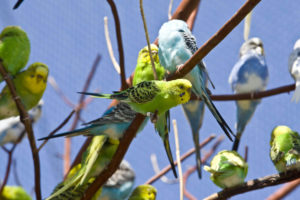 It’s like being inside a cloud of excited children who’ve all been given a bright yellow jacket and two cups of coffee.
It’s like being inside a cloud of excited children who’ve all been given a bright yellow jacket and two cups of coffee.
We’re inside Budgie Buddies on a sunny spring morning – perfect budgie weather, says keeper Ariel Woodruff. She and fellow keeper Heather Burns have been doing the spring cleaning before this popular habitat opens up for visitors on May 4: adding new perches, pruning greenery and doing lots of pressure washing.
For the budgies, zooming noisily around in a brilliant yellow-and-green squadron, it’s the perfect combination of enticing weather and good company.
“They’re really charismatic, and they all have their own personalities,” explains Woodruff, gazing around like an adoring playground parent. “But they’re a lot like small flying puppies. That’s what I tell Zoo guests when they ask if they make good pets – yes, they do, but not for everyone. You have to be committed!”
Small, flying, colorful puppies
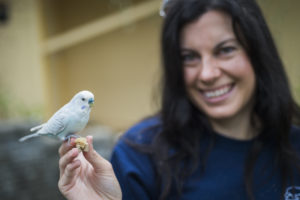
Woodruff and Burns have been caring for the Zoo’s flock of budgerigars (also known as parakeets) for a combined five years full-time, and part-time before that. While they also help out with animal care at the Wild Wonders Outdoor Theater, looking after more than 100 of these Australian birds is a job that requires constant attention.
First, there’s the mess.
“Cleaning is a big part of the job,” admits Woodruff with a big smile. “Every day we spend most of the morning cleaning their inside area, and in summer this includes the outside habitat.”
While Budgie Buddies is open to guests from May through September, the birds get free indoor/outdoor access all year round as they choose. Mostly they stay inside during cold weather, but it’s unpredictable, says Burns: “Last time we had snow they clearly thought it was budgie party time outside.”
Next comes checking on chicks and any sick birds, and setting out pellets and seeds for breakfast. For dinner, the birds also get fresh fruit and veggies.
Finally, after a bit more cleaning, there’s enrichment. As curious birds who peck, build nests and perch on a variety of surfaces, budgies need new enrichment items every day: hanging chains, raffia, cuttlebone, coiled branches, wooden mobiles and blocks. Today there’s also a dangling 2016 calendar that’s been thoroughly dismembered by eager beaks.
“They love to destroy things,” says Woodruff, grinning.
Noisy, social and wild
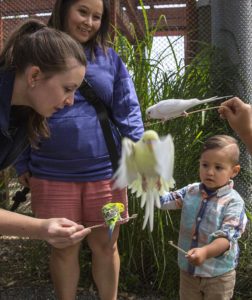
But an equally big part of being a budgie keeper is talking with the birds’ greatest fans: Zoo guests.
“Our goal is to get people to see birds as real animals, and as super-exciting,” explains Woodruff, who takes it in turns with fellow keepers to chat to guests as they wander into Budgie Buddies, seed stick in hand. “We are so used to hearing their chirping in pet stores that we don’t really think about their traits in the wild.”
In Australia, budgies live in huge colonies of up to 25,000 birds. They nest in trees or fence posts, with females fighting for the best spots, and laying clutches of up to eight eggs that hatch after a few weeks. Chicks hatch featherless, quickly growing downy gray fluff before fledging those distinctive speckled aqua, lime green or yellow flight feathers.
Here at the Zoo, springtime means baby budgies, and Burns carefully lifts off the top of a nest box to check on five tiny chicks nestled in a fluffy bundle. Part of the fun of being a budgie keeper is naming chicks – and it’s a Zoo tradition to give each clutch quirky names that often relate to the parents’.
Dragons and dinosaurs
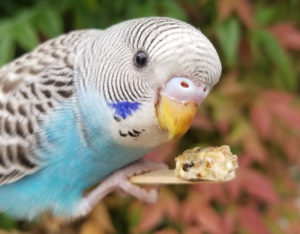
“So Pirate Pete’s clutch all got pirate names – there’s Swashbuckle over there,” points out Burns. “And Alderaan, she’s from the Star Wars clutch.”
Then there was the dragon clutch (named after dragons from folklore), the baseball clutch (Wrigley, Fenway and Kaufman), the dinosaur clutch, and a clutch named after famous naturalists (Attenborough, Goodall).
Naming the chicks before they show their gender (via the color of their cere, or nose area) just adds to the fun: Han Solo actually turned out to be female.
Woodruff, who has family in Australia, has lately been inspired by Aussie bakery treats: Mint Slice, Lamington (a kind of coconut cake) and that iconic Australian chocolate cookie, the Tim Tam.
It’s a fun tradition but it also helps keepers identify each bird and give the personal interaction that helps them thrive.
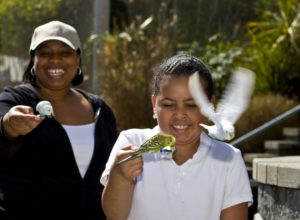
“Like Carl, his mom Junior and grandma Frankie, they all loved to groom and would fly down and manipulate our hair,” says Woodruff. “It tickles, but it’s cute.”
As Burns and Woodruff talk, their eyes are constantly following budgies around, noting who’s interacting with whom. They take time to give Flounder – a quieter bird who has trouble flying – some extra attention.
But they do it with big smiles, and the gentle patience of the best preschool teachers.
“It’s a happy place,” says Burns.
“Yep, it’s like our feathery family,” adds Woodruff.
MEET THE BUDGIES: Budgie Buddies opens for the season May 4, 2019. Come visit or learn more here.
HOURS: 10:30am – 2pm Mon-Fri; and 10:30am-1pm & 2-5pm Sat-Sun.
FEED THEM: Buy a seed stick or two ($2/$1.50 members) at the kiosk nearby and hold it out. The budgies will fly down and start nibbling!